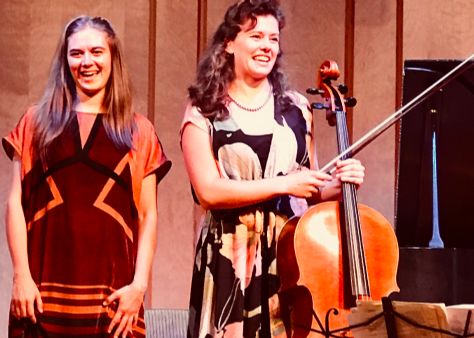|
Symphony
FROM THE NEW WORLD TO THE OLD WORLD
by Peter Lert
Saturday, June 14, 2025
Chamber
MC2 DUO RECITAL CLOSES 222'S SEASON
by Terry McNeill
Saturday, June 14, 2025
Choral and Vocal
CANTIAMO SONOMA'S LUSCIOUS A CAPELLA SINGING IN SEASON ENDING CONCERT
by Pamela Hicks Gailey
Sunday, June 8, 2025
Symphony
SRS SEASON ENDS WITH RESOUNDING TA-TA-TA-BANG
by Terry McNeill
Sunday, June 1, 2025
Symphony
YOUTHFUL VIRTUOSITY ON DISPLAY AT USO'S MAY CONCERTS
by Peter Lert
Saturday, May 17, 2025
Symphony
MYSTICAL PLANETS AND LIVELY GERSHWIN ORTIZ AT FINAL SRS CONCERT
by Peter Lert
Sunday, May 4, 2025
Symphony
VSO'S CONCERT MUSIC OF TIME, MUSIC OF PLACE
by Peter Lert
Sunday, April 27, 2025
VOCAL ELEGANCE AND FIRE AT THE 222'S RECITAL APRIL 26
by Pamela Hicks Gailey
Saturday, April 26, 2025
CANTIAMO SONOMA SINGS AN INSPIRED GOOD FRIDAY MOZART REQUIEM CONCERT
by Pamela Hicks Gailey
Friday, April 18, 2025
DRAMATIC SHOSTAKOVICH SYMPHONY CLOSES PHILHARMONIC'S 25TH SEASON
by Terry McNeill
Sunday, April 13, 2025
|
 |
 A. Gabrielson and S. Myklebust Acknowledge Applause Sept. 9 in Occidental (J. McNeill photo) |
DUO WEST OPENS OCCIDENTAL CONCERT SEASON
by Terry McNeill
Sunday, September 9, 2018
Before a full house at the Occidental Performing Arts Center Sept. 9 the cello-piano Duo West, playing from score throughout, presented a recital that on paper looked stimulating and thoughtful.
Beginning with MacDowell’s To A Wild Rose (from Woodland Sketches, Op. 51), the transcription by an unannounced arranger made little impact and probably was something novel to most of the audience. An odd choice not explained, but the Fauré D Minor Sonata (Op. 109) that followed was explained by the artists wielding two microphones with an extended interplay of commentary. The audience seemed to enjoy the descriptions of simplistic ideas of contrast in musical composition.
A work from late in the composer’s life, the Sonata’s charms and harmonies are complex and elusive, and cellist Sonja Myklebust’s round sound was well placed for the uneven phrases and unique rhythms. Pianist Abbie Gabrielson had good ensemble with Mr. Myklebust but her playing lacked individuality, and wasn’t helped by the hall’s sub-professional instrument with its wooden sonority and subdued treble.
The Sonata’s best playing was in the lovely andante’s long line and wandering melodies. Bow control here was good and the playing had rich tone in the many modulations. In the finale the duo chose a tempo that was too slow for bringing out the urgency of the music, especially at the end where the momentum in the cello part builds to a joyful climax. The composer’ sobriquet is “Old Arpeggio,” and Ms. Gabrielson added a few inner voices to the delightful swirl of arpeggiated chords.
Before intermission Arvo Pärt’s ten-minute Spiegel im Spiegel was an audience favorite, with Ms. Myklebust’s vibrato widening and the long minimalist exposed line captivating. Cello intonation was very good and the vital clarity of the long-held note changes was excellent. Mild dissonances in the piano part added to the piece’s mystery, with just one blurred cello entry point note and a fetching swelling of vibrato at the concluding fermata. The ovation was long and loud.
Shostakovich’s popular 2nd Sonata, Op.40, came after intermission, and echoed a performance four days earlier at Santa Rosa’s Spring Lake Village Concert Series. In both performances the tempos were on the slow side, diluting the momentum and often sarcasm of the composer. But there is rhapsody in this music, and none of the banality of the cello’s theme in the First Cello Concerto. But Shostakovich does wonders with banal themes, and Ms. Myklebust projected themes alluringly with fine control in pianissimo passages. Pitch was sporadically off when coming down from a high-register quiet notes. There were references here to the composer’s Fourth Symphony, something I had not heard a cellist do before in the D Minor Sonata.
The exciting scherzo was played with an appropriate harshness and again a judicious tempo, leading into the long phrases of the largo. The Duo West gave it a gripping reading, underscoring the dissonances and strange transitions. Sadness trumped melancholy. A program highlight
The finale’s dramatic juxtaposition with the largo followed, with a much lighter instrumental texture, acerbic tunes and a cascade of piano notes.
Ginastera’s Pampeana (Op. 21, No. 2) closed the concert, a bravura work reminiscent of the composer’s Danzes Argentinas. The playing had the right amount of frantic rhythms and heavy textures, but also some leavening fantasy. Repeated phrases and raucous sforzandos from Ms. Gabrielson were telling additions to Ms. Myklebust’s double stops and admirable virtuosity.
|

